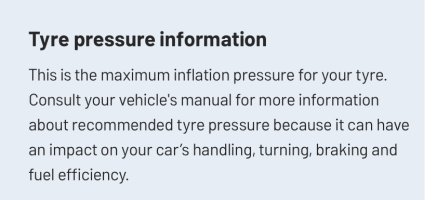K
kibondo22
Im confused about tyre pressures....!
Im have 235 / 55 / r17 size tyres
I have direct pressure monitoring on my t6.1 - and have always been keeping to the recommended pressures as indicated on the sticker on the b-pillar / in numbers in brackets in the cockpit (i.e. 3.0 bar / 44 psi front and 2.8 bar / 41 psi when unloaded).
However, this lead to severe wear especially on the shoulders of the front tyres and i just had them replaced.
the garage that fitted them set the pressure at 4.0 bar / 58 psi! - which ive seen other websites also recommending for the same size tyres (e.g. CamperKing)
and searching again for what people use on here - im seeing in many threads recommending as high as 50 psi for the same size 235/55/r17
So are most people finding that the VW recommended pressures on the b-pillar are too low - and its better to err on the higher side...!??!
Im have 235 / 55 / r17 size tyres
I have direct pressure monitoring on my t6.1 - and have always been keeping to the recommended pressures as indicated on the sticker on the b-pillar / in numbers in brackets in the cockpit (i.e. 3.0 bar / 44 psi front and 2.8 bar / 41 psi when unloaded).
However, this lead to severe wear especially on the shoulders of the front tyres and i just had them replaced.
the garage that fitted them set the pressure at 4.0 bar / 58 psi! - which ive seen other websites also recommending for the same size tyres (e.g. CamperKing)
and searching again for what people use on here - im seeing in many threads recommending as high as 50 psi for the same size 235/55/r17
So are most people finding that the VW recommended pressures on the b-pillar are too low - and its better to err on the higher side...!??!













